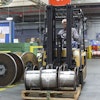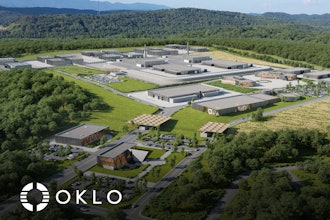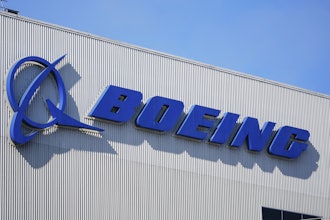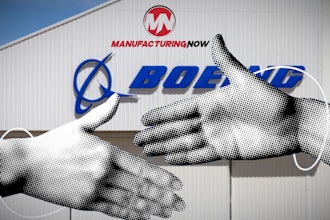
IncreasIng BusIness
growth usIng FlexIBle,
end-to-end erP
Brought to you By:
Page 2 | ePicor irePort
changes to the
ManuFacturIng
landscaPe
a few key events over the past few years have caused
notable disruptions in the manufacturing environment.
First, the industrial internet of things (iiot,) or industry 4.0
as it is also called, has brought about the next evolution
in industrial manufacturing. Leapfrogging from the use
of computers on the shop floor in the 1980s to a fully
connected, automated infrastructure, iiot impacts
manufacturing beyond the four walls of the plant. the reality
is that real-time data and insights are exchanged not only
between machines, but across larger networked systems
throughout the entire business environment.
Nowhere is this information sharing more evident than in the
next business disruptor, the “amazon effect.” this singular
organization has redefined what any customer, business
or consumer, anticipates in the way of visibility from the
moment they place their order (and sometimes, even
before the order is placed!) through to final delivery.
With expedited shipping, easy reorder options and intuitive
comparative shopping, amazon has changed how people
interact with a company, and its partners, during any given
transaction. and this holistic buying model has rolled over
into the expectations of the manufacturing customer.
Lastly, incoming talent has higher expectations for their work
environment, looking for companies that have embraced
technology by integrating it into the business processes.
No longer will manual data entry or excel spreadsheet
calculations be sufficient. Employees look for a stable,
forward-looking infrastructure that is intuitive and easy to
use, and that will facilitate growth and efficiencies.
Just as amazon has raised the bar on customer
expectations, the proliferation of technology in everyday
life has increased an employee’s demand for intuitiveness
within their work environment. Manufacturing businesses
need to look for ways that balance how the existing
business runs with what it needs to look like in the future.
IncreasIng BusIness
growth usIng FlexIBle,
end-to-end erP
connections. You make them every day with your
customers, your employees, your vendors. it’s been this
way since the dawn of business, so why does it feel like the
relationships are changing?
Business models across every industry are being challenged.
customers expect transparency in every aspect of their
order, from procurement to delivery and beyond with after-
market services. employees expect accountability in the
form of advancement opportunities and stable company
growth. Vendors expect collaboration across the supply
chain that will improve margins and increase the ease of
their business processes.
But these ‘demands’ are really opportunities. Manufacturing
companies are finding ways to strengthen relationships and
improve process efficiencies across all business segments
using data-driven insights through a properly implemented
erP system.
By the end of 2020, 50 percent of
Manufacturers Will Derive Business
Value from the Integration of Supply
Chain, Plant Operations and Product
and Service Lifecycle Management.
— From IDC Manufacturing Insights, 2017 Predictions
Page 3 | ePicor irePort
how dIsruPted Is your
BusIness?
it seems no parts of a business are
immune from the effects of these
industry disruptors. in addition, supply
chain complexity has increased
and no longer is your competition
limited to the guys down the street.
everything is moving on a global
scale, but just as manufacturing
survived the last three industrial
revolutions, there are means and
methods to capitalize on these latest
shifts as well.
Managing business process change
within an organization can seem
daunting. But evolving into a data-
driven manufacturing facility doesn’t
need to be worrisome. of course,
there are always challenges, and
decisions to be made, but with the
right erP infrastructure, these shifts are seamless and can
happen in phases, when it is right for the business.
rethInk your status Quo
What areas of your business currently run smooth? What
aspects cost you the most? are there ways to make your
processes more efficient, or utilize your talent and resources
better?
typically, companies looking to implement or upgrade an
erP system come to the table with a pain point that needs
to be addressed. it could be something as simple as moving
from paper to an automated system or something more
complex, like undertaking a legacy software upgrade.
either way, knowledge capture is essential to wind up with
an end-to-end system that encompasses what your business
needs, from design to delivery.
Digitized processes enable rapid information sharing,
keeping all operations aligned and able to work better
together. When you look at the hard facts of time and costs
savings using modern erP systems, the need to be relevant
clearly outweighs “we’ve always done it this way.” (Sidebar
1: Kroll International)
A 2017 report from McKinsey and Co. notes that advanced
analytics can improve margins from 4-10 percent, while
machine downtime can be reduced by 30-50 percent and
machine life can increase by 20-40 percent, if data is used
for predictive maintenance.
ManagIng change FroM
the InsIde out
even though your process may not be broken, it may not
be providing you with the information needed to make
strategic business decisions for both day-to-day operations
as well as for long-term growth goals.
resistance from employees is to be expected, but by
showing how a more connected system will improve
efficiency, eliminate redundancy and provide them with
a better work environment, these fears can easily be
overcome. there’s no reason that automated processes
need to mean a change in business culture, except in
terms of creating a more collaborative environment, where
business segments work closer together, providing deeper
insights that will equate to better operations overall.
Flexibility in implementing an erP system means more
willingness to adapt to a new norm, versus being forced to
accept one. reinventing your organization doesn’t mean
abandoning who you are.
Page 4 | ePicor irePort
a strategy FIt For
growth
a common misconception of erP systems is that they
completely uproot an organization’s infrastructure, causing
production delays, operational nightmares and more
headaches than they are worth, but nothing is farther from
the truth. Scalable systems help to manage the process
effectively, allowing a business to select and implement only
the needed components as it makes sense for the business.
in fact, some systems even offer modules that help optimize
specific manufacturing operations. (Sidebar 2: Card-
Munroe)
Your ERP system should fit your specific business needs, not
force you into changing your processes to integrate with
the confines of the software. Look for a system that offers
scalability, such as modules that solve specific business
problems, so you aren’t overpaying for functionality or
utilizing solutions that don’t make sense for your operation.
IdentIFy BusIness needs
Different areas of manufacturing operations require distinct
insights. The shop floor uses data differently than your
warehouse or distribution center. Which insights will help
you learn how to improve operations in specific segments
of your operations? What areas can be easily modernize to
increase efficiencies and quickly put you on the path to ERP
success?
as customers continue to demand transparency across
the supply chain, will your manufacturing capabilities and
distribution strategy answer the questions that are being
asked, or are there gaps in the process that need to be
addressed?
You make decisions that help your business run on a daily
basis. a properly implemented erP system will help facilitate
operations and enable predictive business decisions based
on interconnected networks of real-time data.
The future-proof manufacturer will
be able to provide highly-personal,
flexible products where and when
the buyer needs them, versus large
quantities of homogenous products.
— Factory of Future paper, page 12
dIgItal transForMatIon
Made easy
intelligence is being designed into every aspect of business,
and erP systems are designed to help manage the growing
amount of data available across your supply chain through
to your business operations.
Before you begin evaluating erP solutions for your
manufacturing environment, ask yourself these questions to
help simplify the process of selecting the right system:
• What does the business look like today?
• What do we want to become, and by when?
• How can we achieve this?
• Where can an erP system help?
• Where do we excel? Fall short?
• What current trends do we need to address?
• What is the most important area of the business to
strengthen?
• What gaps do we have in resources? in available data
insights?
take stock of all available resources and consider current
best practices of available ERP systems:
• Cloud computing for flexible access to real-time data
• Scalability for multiple deployment options
• Useful tools that manage data and provide clear insights
• Customizable elements tailored to your specific business
• Long-term lifecycle that evolves with your organization
• ongoing technical support that keeps your solutions easy
to use
Page 5 | ePicor irePort
growth Beyond the shoP
Floor
Keeping pace with your customers is a significant business
driver. increasingly, industrial manufacturers are being
asked for more flexibility in the order process, with requests
for make to order (Mto), engineer to order (eto) and
configure to order (CTO) becoming far more the norm
than the exception. With better inventory management
and integrated system functionality, a digitized business
environment will enable quick responses, reduced lead
times and more efficient manufacturing.
in fact, it’s common for users that have migrated from
legacy or homegrown systems to an integrated erP systems
to identify new efficiencies and improved business process
that were previously unrecognized.
Employees are able to work more efficiently, and modern
erP tools use intuitive interfaces that match the user
experience employees have grown accustomed to,
especially for those newer to manufacturing. By providing
elements like automated data processing, touchscreen
interfaces and portable electronic devices, businesses
are elevating the work experience and setting a solid
foundation for the workforce of the future.
and a more holistic view of your business means you can
engage partners and distributors better, for increased
success from start to finish. Not only are you making your
company easier to operate, you’re making it easier to do
business with your company.
What’s Next?
erP serves as the foundation of your manufacturing
infrastructure, so implementing a system on your terms
should mean better costs control and using technology at a
pace that makes sense for your operations.
Select a system that will help align your operations, then
evolve with your business, identifying ways to optimize
resources and track inventory, automate processes to
eliminate errors and put you in a position to plan for supply
chain disruptions.
once the infrastructure is in place, the next level of insights
erP provides is identifying new growth areas and how to
compete better in a global environment. the total impact
of selecting a system that fits your business needs, versus
one that expects your processes to fit its model, will ease
the transition to a digital environment and position your
company for growth.
Quantifiable metrics, wireless capabilities and an
advanced level of data processing using erP has
transformed the operations of a 35-year old wholesale
supplier of law enforcement, tactical and safety gear.
With the visibility to know where products are and
where any order stands as well as the ability to locate a
customer order at a moment’s notice, the company’s
operations are both agile and responsive. By using
available data, smarter decisions are being made
for space utilization in the warehouse and for order
fulfillment that now enable same day shipping of orders
placed before noon.
Not only can ERP systems be implemented for specific
business functions, but some systems offer industry-
optimized modules designed to meet the nuances of
specific manufacturing environments.
one implementation at a manufacturer of custom-
built tufting equipment relied on epicor’s strong
manufacturing and inventory capabilities, as well
as integrated accounting and built-in system tools,
to enhanced shop flow and collaboration among
employees.
About
this report
About epicor
the information in this i-report was
researched and produced by
Manufacturing.Net in conjunction with
epicor. Statistical data was researched
and compiled by advantage Business
Media in April 2018.
epicor Software corporation (epicor.
com) provides industry-specific
business software designed around
the needs of manufacturing,
distribution, retail and services
organizations. epicor’s more than 40
years of experience with its customers’
unique business processes and
operational requirements is built into
every solution — in the cloud, hosted
or on premises.






















